VW Passat B7 Tuning Mods
"A look at the best upgrades and mods for your B7"
When the seventh-generation Volkswagen Passat was introduced in 2011, it was more of a complete redesign of the Passat B6 than an entirely new vehicle with a more refined, controlled, and pleasant ride. It ran until it was replaced by the B8 in 2015. The evolution from the B5, B6, B7 to the B8 shows clear advances, whilst evolutionary rather than revolutionary.
A true competitor to the BMW 3 Series and Audi A4. Additionally, they developed a more robust Passat Alltrack, which competes directly with the Audi A4 Allroad and Volvo V60 Cross Country.
The Alltrack's four-wheel drive, a slew of visual changes, and a slew of desired amenities make it an excellent secondhand option to an SUV.
We would select the 16-valve diesel engines since they combine economy and performance. For instance, there is a 1.6-liter unit capable of 140 horsepower and a 2.0-liter one capable of 200 horsepower. With tunes or remaps these can offer phenomenal power gains and are quite easy to live with.

Which engine would we go for in a B7 Passat?
Anything less than 140bhp would seem sluggish on such a wide heavy platform; the later TFSi engines are good alternatives, and the 170TDi is a true performance jewel; nevertheless, it may be difficult to live with if you only travel short distances due to the DPF issues that can crop up.
Please watch our video introduction to VW Tuning.
Gasolene engines
1.4 TSI 2010-2015
- 122 PS (90 kW; 120hp @ 5000 200Nm (148lbft) @ 1500-4000
1.8 TSI 2010-2015
- 160 PS (118 kW; 158hp @ 5000-6200 250Nm (184lbft) @ 1500-4200
2.0 TSI 2010-2015
- 210 PS (154 kW; 207hp @ 5300-6200 280Nm (207lbft) @ 1700-5200
3.6 V6 4MOTION 2010-2015
- 300 PS (221 kW; 296hp @ 6600 350Nm (258lbft) @ 2400-5300
Natural Gas LPG
1.4 TSI EcoFuel I4 DOHC 16V FSI twincharger 2010-2015
- 150 PS (110 kW; 148hp @ 5500 220Nm (162lbft) @ 1500-4500
Diesel engines
1.6 TDI CAYC -2011
- 105 PS (77 kW; 104hp @ 4400 250Nm (184lbft) @ 1500-2500
2.0 TDI CBAB-2011
- 140 PS (103 kW; 138hp @ 4200 320Nm (236lbft) @ 1750-2500
2.0 TDI CLLA, CFGB -2011
- 170 PS (125 kW; 168hp @ 4200 350Nm (258lbft) @ 1750-2500
2.0 TDI CFGC -2014
- 177 PS (130 kW; 175hp @ 4000 380Nm (280lbft) @ 1750-2500
2.0 BlueTDI CFF/CFFB -2011
- 140 PS (103 kW; 138hp @ 4200 320Nm (236lbft) @ 1750-2500
Our objective in Passat engine tuning should be to boost top-end power and torque.
The most significant power improvements occur with bigger engine sizes. The more you start with, the greater the return on investment, which is why engine swaps are a cost-effective modification for small engined vehicles.
Can you tune a Passat B7?
There are many upgrades around for it since it shares a platform with the A4 and Exeo etc. The range of Passat engines is also installed in many different models around the VAG group ensuring a big range of parts are available to enhance your powre.
VW Passat B7 Tuning modifications.
These mods sports parts are usually installed by our members, decide how far you wish to go in your tuning project before you get started.
We've covered quite a few VAG group engines on here, some of which may make a suitable engine swaps candidate for your B7 Passat.
Please don't expect to buy the lowest power Passat and then upgrade it to match the higher powered one, it usually works out far more than just buying the performance variant in the first place
- 1.4 1.5 TFSi tuning
- 1.4 TSi/TFSi/Twincharge tuning
- 1.8T engine Tuning
- 1.8 & 2.0 TFSi (mk1) Tuning
- 1.8 2.0 TFSi (ea888) Tuning
- 2.0 TFSi carbon issue & care guide
- 2.5tfsi tuning
- 3.0 V6 24v TFSI Tuning
- 2.8 V6 30 valve, 24 valve 3.0 V6 30v and 3.2 VR6 Tuning
- 3.6 VR6 Tuning
- 1.6 TDi tuning
- 1.9 TDi tuning
- 2.0 TDI 140-170 tuning
- 2.0 TDI tuning (EA188)
- 2.5 TDI tuning
- 2.7 & 3.0 TDI tuning
- 2.5 Tdi R5
- 3.0 Tdi EA897
Obtaining appropriate customized components for your intended use of the vehicle saves both time and money. Stage 3 motor sport components just do not perform effectively on the road, making driving the vehicle tough.
Please view our video on VW Passat Mods & Tuning. Subscribe to our new channel and show your support.
Best mods for your Passat B7
- Engine Tunes - A Remapped Passat B7 ECU offers the biggest gains for your investment, aftermarket ECUs, and piggyback ECUs are all alternatives.
- Intake Upgrades and high flowing exhausts - Please be warned on their own these mods won't ADD HP on most cars, but they can help enhance power after other mods by lessening the restriction.
- Brake Mods - Improve your ability to stop ought to be near the top of your Mods list.
- Lighter flywheels - a lower mass flywheel will noticably improve the engines rev changes. Not always beneficial for all Passat B7 engines.
- Flowing and porting the engine head - for larger gains, you will get better flow and make a more efficient engine if you do this to support your other mods.
- Fast road cams are generally the biggest mechanical mod upgrade, but ideally be installed by someone qualified to set them up properly and some cams are hard to find but you'll probably find a local firm to regrind a stock cam for you.
- Upgrades to turbochargers and superchargers - A New Turbo is the most efficient approach to raise the intake air supply, which permits you to burn more fuel and make power gains. Typically one of the most technically difficult upgrades it offers big gains.
- Passat B7 Suspension Upgrades - Replacing worn bushings and shocks radically improves your Passat B7 handling Coilovers and Bushings are the usual go to mods
The Passat B7 tuning stages
Taking a staged approach to tuning from easy to install and setup mods to the more complex we would see something like this....
Typical stage 1 mods often include: Suspension upgrade (drop 21mm - 39 mm.), Panel air filter, Alloy wheels, Sports exhaust, Engine Tunes/Remapping, Lighter flywheel.
Typical stage 2 mods often include: Power/Sport clutch, Ported and polished head, Fast road cam, high flow fuel injector, fuel pump upgrades.
Typical stage 3 mods often include: Sports gearbox, Internal engine upgrades (pistons/head/valves), Adding or upgrading forced induction (turbo/supercharger), Engine balancing, Competition cam.
Peak power is all well and good but for a daily driven car you need a wide power band and perhaps extending the rev range.
Let's have a look at the modification possibilities and options available to you for your Passat tuning project.
The Passat is a logical option for families while yet providing an enjoyable drive.
Typically, handling adjustments are your first port of call when it comes to the Passat. Drop the vehicle up to 35mm and install stronger dampers; larger drops would often need further modifications.
Passat B7 Suspension Mods.
Fast cornering is important on the track, and suspension plays a role. The track is forgiving, so you can use harsh suspension and lower the car for better aerodynamics and a lower center of gravity.
As the Passat gets older the rubber suspension bushings will degrade, you might hear squeaks, rattles, and bumps and the suspension will not be as tight as it could be.
So your first step in improving the basic setup, and switching to polyurethane bushings is a great idea.
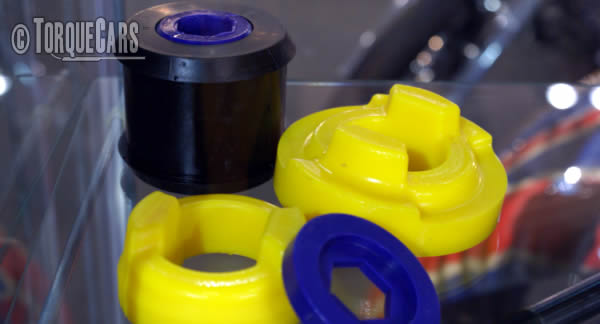
So, when setting up and picking your daily driver's suspension, what variables and factors must you consider?
When designing a car's suspension, engineers must consider speed bumps, uneven surfaces, passenger comfort, and road noise.
Most factory automobiles have soft suspensions that don't maximize handling or driving pleasure. Track vehicles are set up for driver choice and style, therefore the optimal setting is not just subjective but also depends on the track characteristics.
A good suspension system keeps the tires on the road at the ideal angle for maximum contact area. Body roll must be minimized, and the car's center of gravity must be low. For hot hatches with upgraded suspension, Torquecars recommends a 30mm drop.
Common Suspension Mistakes & Urban Myths.
Buying a non-adjustable suspension package that lowers the car 30mm and expecting it to be perfect.
Most kits are highly generic, and suppliers often indicate that they can be used on any or many types of an automobile.
It's quite false to say that one suspension fits all for all engine, wheel, and Passat weights (the diesel engines are pretty heavy).
Incorrect final drive to wheel hub angle might damage the drive shaft and gearbox.
Changing the ride height also affects how the suspension moves under load, causing scouring and premature tire wear!
It's also a bad idea to buy reduced springs and use regular dampers, or upgrade dampers and use standard springs. The suspension system as a whole should be evaluated as a whole.
Affecting Ride Height Cars look good slammed low. But you lose ground clearance, tires rub in wheel arches, and speed bumps become insurmountable impediments.
Remember that speed bumps will strike the sump and take off the bottom of the engine and most of the front skirt of a lowered car. Lower does not always mean better.
TorqueCars recommends a 35mm drop for most road cars, and a 30mm drop for Passats with upgraded suspension (sporty versions which already have lower suspension).
With regular suspension and 17” rims, these tolerances may be substantially lower, but lowering the car may cause all sorts of issues.
The goal should always be to improve handling, and lowering the automobile reduces airflow under the car, which helps stability.
Remember to use matched lower springs and shocks. The concept of cutting the springs is a terrible one since you are asking a piece of metal engineered to work with a tolerance to do so.
Cut springs will shatter or break without warning - NEVER CUT YOUR SPRINGS!
Ideally, you should acquire a suspension package that can be quickly modified on the automobile to fit your driving style.
A good set of coilovers will help allowing you to adjust them to suit your driving style. Koni, Bilstein Eibach and KW
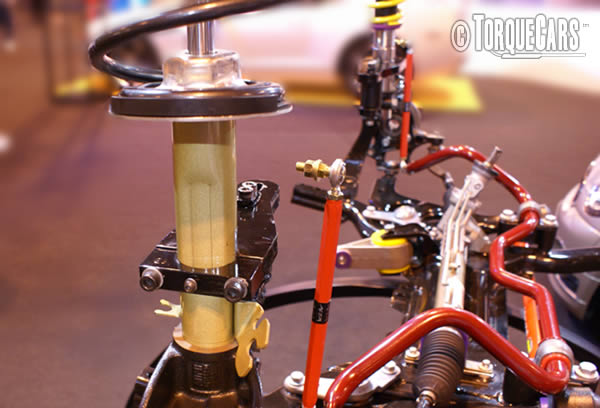
B7 Passat Brake upgrade mods
Bigger brake disks come to mind, but don't forget the pads - these are probably more important than the disks, and indeed bad pads can ruin your Passat's handling.
Brakes are vital — moving fast means being able to stop quickly! A brake works by pressing a friction pad against the disc, converting kinetic energy into heat.
This head dissipates, slowing the car's forward motion. Extensive braking causes brake heat buildup, as seen in night time motorsports where the brakes glow with heat after heavy use.
To offer you a nice progressive sensation, when you press the brake pedal, the force is transferred to a magic box called a servo, which uses engine power to magnify your foot pressure.
The extra pressure is supplied to the friction pads via a tube filled with braking fluid (liquids do not compress like air).
The braking fluid itself can become quite hot towards the hot brake pad end, putting additional demands on the brake fluid.
Brake fluids are hygroscopic (they attract water particles) and can boil at high temperatures - air bubbles in the brake fluid create a spongy sensation at best and can entirely prevent the brake from working at worst which is why you have to change the fluid regularly. (See our article on Brake Fade for additional information on this issue.)
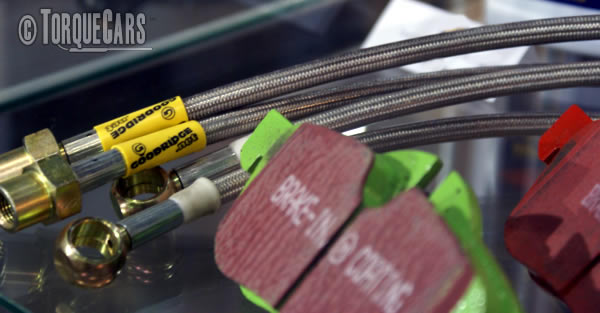
The pad dissipates braking heat over the discs, therefore the cooler the disc, the better.
The vented disc, with its central channel, boosts the disc's surface to air ratio, resulting in better and faster cooling.
Drilled discs assist maintain the pads ‘clean and sharp' by increasing the air ratio and preventing gas build up between the pad and the disc. Bigger discs = better cooling, although they may necessitate a different alloy wheel.
Pad materials. However, high friction brake pads are needed, even if they produce noise and dust.
Racing pads are made with a high friction compound that works best at higher temperatures.
Because race grade brake pads only work when very hot, they are unsuitable for road use where braking is done on cold pads or in short bursts.
TorqueCars has determined that fast road pads from Pagid and Black Diamond are a good compromise between braking and wear.
Some performance brake pads produce almost no brake dust and last longer than the normal pads I was using — albeit driving style will affect pad and disc wear. When the ABS detects a lockup, it releases the brake until the wheel turns again on larger discs you get more progression when this happens so it is less likely to lockup as there is a wider margin to work in.
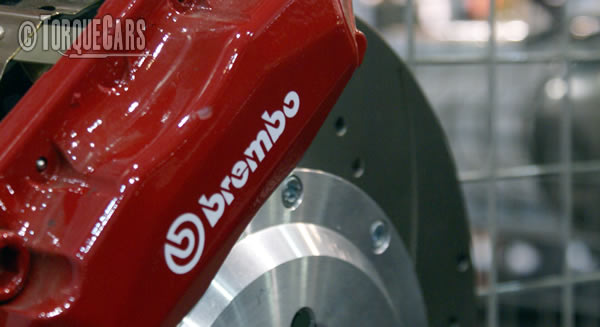
If you're not a mechanic Torquecars advises leaving brake work to the professionals to avoid accidents. Upgrade your brakes.
A car's stopping power can be improved. Normally you'd upgrade the discs and pads. A larger disc will have more friction and disperse more heat, so you will instantly benefit.
With a big disc conversion kit, you will have greater braking feel and can detect the point of lockup easier.
If you have a basic family car with small discs, you may easily and cheaply purchase brake disks and servos from a performance model in the same family.
The performance brakes (if they fit into the alloy wheels or you need to acquire wider rims) are normally standard on a small family car.
Small cars often share parts with larger executive cars, so a little study and discussion with our forum members can help. Brakes from VW, Audi, Porsche, Skoda, and Seat are interchangeable because most hubs are interchangeable.
Next up are calipers (which apply the clamping force) and pistons (which push the calipers).
The more pistons you have, the more clamping force you have, allowing you to employ larger pads.
It's not as simple as creating a dog bone adaptor to put them onto the factory (or larger discs) to replace the factory single piston sliding calipers!
The overall volume of brake fluid utilized must match the amount used in the donor automobile master cylinder. The pedal stroke and sensation will be altered, and the pedal will likely move closer to the floor before the brakes operate.
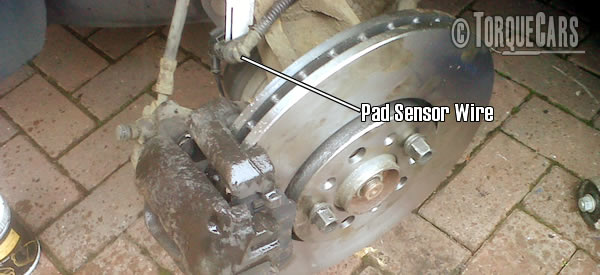
To match the donor vehicle's master cylinder volume, the factory master cylinder may need to be overbored or replaced with a larger unit.
To maximize the effect of upgrading the discs, increase the pad, caliper, and piston count.
Remapping the Passat B5.
Why are OEM maps so bad? Local variances in fuel emission regulations and temperatures usually necessitate a fudging of the one setup for all method.
Manufacturers develop timing maps with a large margin of error to account for temperature variations, minor faults, and bad weather. Some countries' CO2, HC, and NOx emission targets differ, necessitating a fudged approach.
Manufacturers do not want customers to be inconvenienced by mechanical failures or poor fuel economy, therefore they build in a large tolerance.
The fact that different countries utilize different gasoline grades and have varying degrees of adverse weather adds to the fudge that has to be done to keep all cars functioning well globally.
Depending on how effectively the components are machined and assembled, each car's output varies by 20bhp. Rather than examine each automobile individually and create a custom timing map, they use a one-size-fits-all approach.
Manufacturers employ tunes or remaps to create multiple power versions of the same engine, lowering insurance rates and improving fuel economy.
Add to that the reality that the average TorqueCars reader will be upgrading components, and you have a compelling case for a remap.
The manufacturer also factors in user neglect, such as infrequent servicing, unclean plugs, poor leads, clogged air filters, partially blocked injectors, etc. And so on. Whom remap? Anyone who has upgraded their engine should consider remapping.
Remaps are also suggested for all modern turbocharged engines, adding 20-30% additional power. TorqueCars strongly recommends a tune/remap for turbocharged cars with electronically regulated fuel injection.
Remapping Issues and Drawbacks What are the hidden costs?
Prepare to service your car more frequently, sometimes halving the service interval. If the map was tuned for high octane fuel, you must be prepared to replace components that break due to the extra work they are doing. When an engine is tuned for more power, it puts more strain on components, such as air flow sensors.
Weak points in an engine frequently show up months after a remap. See our tune/remap troubleshooting guide.
Generally, any turbocharger and clutch deficiencies will show up following a remap.
Also, turbos can wear out, essential components like pistons and bearings require care, and the clutch is less durable. What about NASP remaps? A tune/remap alone will only gain a few BHP if you don't have a turbo (10 percent is typical).
TorqueCars advises non-turbo automobiles to modify everything else first (cams, pistons, increase compression, engine balance, air intake, exhaust, head work, bigger valves etc...)
After this, you can consider a tune/remap to assist you get the most out of them.
Turbocharged engine care
Also, a tune/remap often introduces boost from lower down the rpm range, causing the turbo to run faster and hotter.
In this case, you must let the turbo cool before turning off the motor, or the oil may degrade, requiring an expensive turbo repair. Installing a turbo timer will also assist keep the engine running until it cools.
Be very skeptical of peak Power Claims Please ignore peak power when comparing maps since some tuners are known to manufacture a power blip or spike to attract attention and grab those headline power figures.
See the graph below which illustrates what we mean.
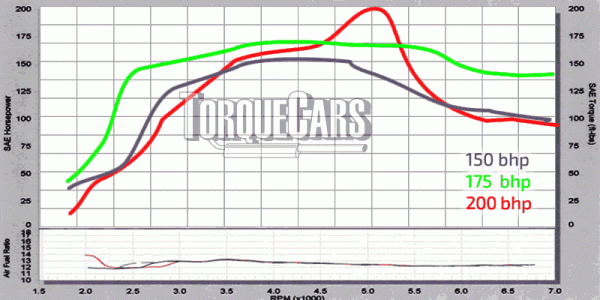
Instead, focus on the total torque curve. More power at the bottom ends the turbo and causes traction issues, whereas more power at the top ends the turbo and components.
The red plot shows an increase in power, but power is down everywhere else, whereas the green trace shows a constant gain in power throughout the RPM range.
It also shows peak power at 4000rpm, which is fantastic for an engine that redlines at 7000rpm, providing you a fair spread of extra power where you need it most.
On a map, we want to see a beautiful smooth torque rise throughout the rpm range, with no dips or troughs.
To find out if the map has ever been tested or studied, you have to go to the company's hidden office, where often you'll find someone with a laptop and they will mess with the fuel and spark advance tables hoping for the best and never actually see the cars they are tuning.
Turbo modifications and upgrades for your Passat
Big turbos provide more power, but they also wear out the engine and cause heat. A turbocharger on a petrol engine may spin at 1100°C and 100,000-150,000rpm.
Some turbo configurations and new models can double those speeds. These speeds necessitate lubrication, cooling, and balance. Its most common problems are oil seal failure, blockage or bearing wear.
Upgrade your turbo in two ways. a hybrid turbo (based on your OEM casing but with internals from another turbo or with a different design)
Install a larger turbo, which requires more pipes and effort to install. The first option simply replaces the original, but requires engine tuning/remapping to really benefit, although most hybrid turbos will function fine on regular maps at lower boost settings.
The air intake aperture shape and size, compressor wheel and turbine profile are the determining factors of the power profile. These can spin faster, compress more air, or boost at high or low RPMs, depending on your needs.
Road cars need low down power, thus a smaller turbo delivers a flatter torque curve with less lag.
A hybrid turbo will also have stronger bearings, greater balancing, and stronger seals. Reduced RPM increases dependability and boost.
A Guide to Volkswagen and Audi Group Turbochargers by VAG
There are a lot of turbocharged engine alternatives out there, so we'll take a look at some of the most popular turbos from the VAG group, as well as the distinctions between them and the best upgrade possibilities.
We also have a look at the turbo's power restrictions, which may be exceeded, but the turbo's lifetime will be decreased.
Before the turbo eventually breaks, you will generally hear a whining or siren sound and then see smoke.
At this time, you should start looking for a new one. If the compressor fails and is pulled into the engine, a failing turbo may do a lot of harm.
Turbochargers From The VAG Group's Newer Generation
The IHI IS12, IS20, and IS38 turbochargers replaced the K03, K03s, and K04 turbochargers which were dependable but these newer versions offer so much more potential to the tuner.
Unlike Audi and VW's stock turbos, the IS12 and IS20 were adapted to operate with their 2.0t MQB engines.
The IS38 Turbo is One of the Best around
The IS38 turbo provides 370 hp with a simple bolt-on (with the proper add-ons).
Its durability has made IHI a favorite. IS38 turbos offer several benefits This turbo is an excellent alternative if you want one that's already installed in many cars.
It is therefore a viable option for those seeking a long-term, high-performance solution with a minimum of installation and fuss.
The IS38 also offers a high turbo output at higher RPMs and a bolt-on turbo for easy installation.
Many hybrids have improved housing and impeller designs, leading in better performance.
High-Performance IS12 and IS20 The IS38 turbos outperform the IS12 and IS20 turbos in many vehicles boosting turbo output.
Why Upgrade Your Turbo?
Turbochargers are often replaced or upgraded for the following reasons: Turbocharger improvements are one of the most effective ways to improve a vehicle's performance.
Turbos need to be replaced periodically. Recent turbos incorporate modern technology and provide car owners greater options.
Choosing Best Turbo Upgrades
There are many fake and low-quality turbo units out there, so it's crucial to research your supplier thoroughly.
If you install a cheap turbo upgrade, we promise you'll have to do it again in six months. Extra things worth looking out for in a turbo include:
A billet aluminum compressor wheel (light and strong) Vanes (Maximizes the boost available) A wastegate actuator (sharpens throttle response and maximizes your power gains) The smallest things may make or break a project. Then tune/remap it.
Upgrading the vehicle's software is customary when replacing the OEM turbo. If not, the engine may run lean or enter limp home mode, resulting in error codes. To fully profit from your upgrade, you must utilize a new ECU, which is only feasible with a stock ECU.
Passat Turbo Swaps
Even though newer and better turbos are always being supplied with new modelcars, changing a turbo for a newer version is not always as simple as it seems. Likewise changing a VAG group turbo to a different brand or hybrid version is a similar challenge. To finish the install properly, you'll need to address the following:
- Replacing outdated fuel injectors to cope with new demands
- Diameter change of exhaust pipe to fit the new turbo
- A new fuel pump is faily easy to install and feeds fuel to the injectors
- Replacing the boost control and wastegate to suit the cars ECU map settings
- Adding uprated intercoolers for cooling as the stock one will become restrictive
- A new wastegate is usually required.
- Less restrictive catalytic converters are worth considering
Most of these will come with a turbo replacement kit, facilitating an easy install of your upgraded turbo.
It may seem like a lot of labor, but it all depends on the engine and turbo chosen. The engine compartment design also influences how difficult it is to swap an Audi turbo into a different model.
The exhaust and intake pipes may need to be rerouted, and the intercooler may need to be enlarged.
Hybrid turbochargers
What's the Deal with Passat Hybrid Turbo Chargers? Why Do People Use Them?
Many companies make straight swap turbochargers, such as Stigan, IHI, and BorgWarner, although many people feel hybrid turbochargers are a better proposition for an upgrade.
Hybrid turbochargers are an enhanced version of the original, made using high-performance components from numerous manufacturers. These hybrid turbochargers solely exist to outperform the standard turbochargers.
How do OEM Turbos & Hybrid Turbos Compare?
To achieve extreme performance, a hybrid turbo may have just one or all of the OEM turbo's components replaced.
Although they seem factory, these turbochargers have been internally modified to improve performance.
Benefits of Hybrid Turbos Hybrid turbos outperform regular turbos in terms of responsiveness and performance due to the use of industry-leading components.
A properly developed hybrid turbo ensures extra pressure and flow while operating at a safe pace.
This assures long-term component life. In general, the more expensive a hybrid turbo, the better the engine. While adopting a hybrid turbo over a normal turbo has certain benefits, it also has some drawbacks.
Remaps of the IHI IS38 on the EA888
Exhaust System Audi, Seat, Skoda and VW enthusiasts will love this turbo since it's capable of producing up to 370 horsepower with the proper tuning!
An Audi and Volkswagen turbocharger, the IS38, is highly acclaimed, and with remapping, it performs at the top of its game.
Revo have produced a stunning IS38ETR V2 which is a logical upgrade path and can make around 500hp with the right supporting mods!
Discuss turbo improvements with us in our forum, or use the comments section to share your knowledge with the rest of our audience.
Is a lighter flywheel a good mod for the Passat?
The flywheel acts between the engine and the gearbox storing rotational energy and smoothing out the engine output by limiting vibrations.
This helps the car withstand speed fluctuations, which is good for cruising but bad when you need a rapid engine response. Disadvantages of a heavy flyweel is that it makes it harder to spin the transmission assembly so slows the engine and its response.
With a lighter wheel, the engine has less strain and can rev freely, producing greater power. Stock engines rev substantially slower than race-tuned engines. Inertial spin is reduced with a lighter flywheel, especially on slopes.
A lighter flywheel loses momentum faster on a hill. With a heavy flywheel, the engine maintains momentum, but the incline reduces energy.
Weighing options for maximum torque and free revving. For street cars, don't go too light or your tick over may suffer. Discuss your idea on the TorqueCars automobile forums.
TorqueCars warns against making your own light flywheel by drilling holes in it. Flywheels in cars are balanced. A wobble in the flywheel might harm the engine and reduce the red line.
A wobble's effects increase with RPM so please ensure you only ever fit a good quality well balance flywheel upgrade to your Passat B7.
Store-bought flywheels are precisely balanced and made of multiple metals for strength and lightness. If you're changing a clutch, replace the flywheel also.
The Dual mass flywheel has two surfaces and a set of springs connects them which slows rotating speed and smooths out vibrations making it ESSENTIAL in diesel engines.
They smooth out 4 cylinder engines and decrease the risk of reversion. Some of our members are replacing DMFs with solid flywheels, however, but we would recommend you read our article on DMF to SMF conversions first the diesels in particular do not work well with lighter flywheels!
Passat B7 fuelling upgrades

Uprated injectors will enable you to supply sufficient fuel to the engine.
Uprate the fuel pump to cope with the extra fuel requirements of your tuned Passat's uprated injectors.
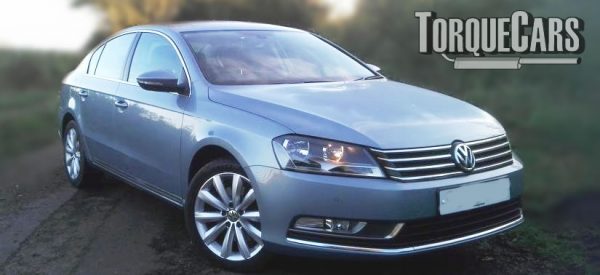
VW Passat Intake and Exhaust.
Now we'll examine the intake and exhaust systems to guarantee appropriate engine operation. A comprehensive induction setup maximizes power improvements. Small engines will lose power, therefore use a panel air filter instead.
Increasing the valve size in the Passat engine heads, as well as doing port work and head flowing, will also enhance torque, and, more significantly, will provide you with the ability to boost the torque increase on other tuning items.
Opening the air intake port to match the intake manifold would not help much unless a step obstructs airflow into the engine. So most DIY port matching is done on exhaust ports.
Extending the port size is only necessary in highly tuned engines when the port size has become a bottleneck.
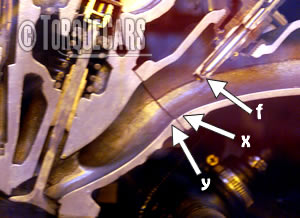
Using thinner channels with fewer bends or angles improves flow rates.
This reduces power; the objective should be to have both port apertures about the same size to prevent turbulence on the downflow side.
In this illustration, a fluid connection between the intake manifold (x) and the engine port (y) is illustrated.
The fuel injector (f) sprays fuel into the intake manifold, directly to the valves (not applicable to direct injection engines).
The intake angle has been reduced to reduce bends in the air flow into the engine. This is not always practicable on all engines, but the goal is to smooth the air flow and reduce bends.
A good fast road power clutch will help to keep that power going where it should.
Never skimp or expect a standard clutch to cope. Remaps offer significant power gains on all turbo charged cars. On NA (naturally aspirated) engines the benefits are doubtful but will help unleash the potential if you have done a lot of mods.
VW Passat B7 Wheel Modifications.
Alloy wheels will help the brakes cool down and are usually lighter than the steel ones. It is worth noting that although they can look cool on the Passat Big alloy wheels will actually decrease your performance.
The larger you go the lower your top speed will be due to the change in your effective final drive ratio. Aim to keep the overall rolling diameter of the wheel the same as supplied from the factory.
In all cases, we do not recommend going above 18 inches. Some of our members have fitted 19's and 20's particularly to fit a Porsche brake conversion but they all reported tram lining and other issues from the larger rim size.
Please join us in our forum to discuss the Passat options in more detail with our Passat owners. It would also be worth reading our Passat tuning articles to get a full grasp of the pros and cons of each type of modification.
Please Check out my YouTube channel, we're regularly adding new content...
PLEASE HELP: I NEED YOUR DONATIONS TO COVER THE COSTS OF RUNNING THIS SITE AND KEEP IT RUNNING. I do not charge you to access this website and it saves most TorqueCars readers $100's each year - but we are NON PROFIT and not even covering our costs. To keep us running PLEASE Donate here
If you liked this page please share it with your friends, drop a link to it in your favourite forum or use the bookmarking options to save it to your social media profile.
Feedback - What do You Think?
Please use our forums if you wish to ask a tuning question, and please note we do not sell parts or services, we are just an online magazine.
Help us improve, leave a suggestion or tip
Please watch this video and subscribe to my YouTube channel.

 Click to accept YouTube Cookies & Play.
Click to accept YouTube Cookies & Play.